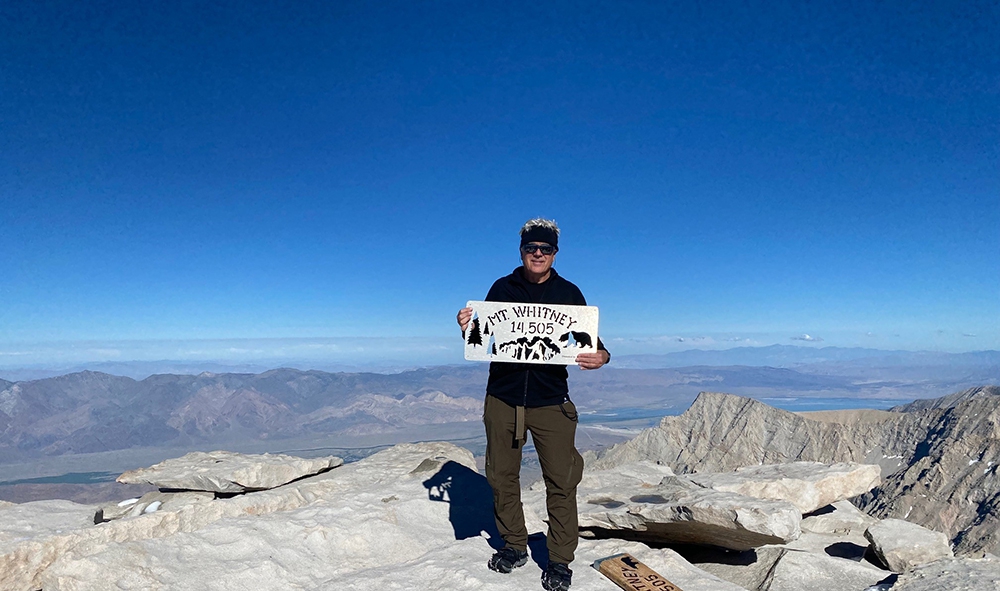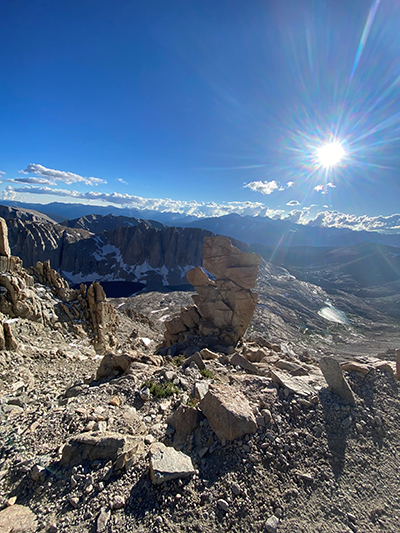Climbing for a cause – ‘It was very overwhelming’ Karl Radke of Axis Communications and Jason Johnston of Genetec reach peak of 14,500-foot Mt. Whitney to support kids in need

By Cory Harris, Editor
Updated 10:14 AM CDT, Wed September 6, 2023

YARMOUTH, Maine—What would you do to support a worthwhile cause? Make a donation, perhaps? Maybe volunteer your time at an event?
How about scaling a 14,500-foot mountain? Well, that may not be the safest way to support a nonprofit organization, but that’s exactly what two security industry pros did on Aug. 23.
Karl Radke, Midwest business area director at Axis Communications, and Jason Johnston, OKR (objectives and key results) practice lead at Genetec, successfully braved the challenging climb to the summit of Mount Whitney in California, raising $2,500 each to support Mission 500, as well as for the Lydia Home in Chicago, another nonprofit that benefits children and families in need.
 Why did they decide to take on this arduous climb up the highest mountain in the 48 contiguous United States to support these two nonprofit organizations? In this exclusive interview, Radke talks with Security Systems News about what led to them taking on this challenge, what obstacles they faced when scaling the mountain, how they felt when they reached the summit, and what it meant to themselves and the nonprofit organizations they raised funds for.
Why did they decide to take on this arduous climb up the highest mountain in the 48 contiguous United States to support these two nonprofit organizations? In this exclusive interview, Radke talks with Security Systems News about what led to them taking on this challenge, what obstacles they faced when scaling the mountain, how they felt when they reached the summit, and what it meant to themselves and the nonprofit organizations they raised funds for.
SSN: Whose idea was it to climb a 14,500-foot mountain to support Mission 500 and the Lydia Home?
RADKE: Jason and I, we’ve known each other for 20 years, and so we have a long history. We get together at least once a month and chat a little bit about things. He gave me this book called “The Comfort Crisis” by Michael Easter.
The book was my inspiration. It outlines how each of us have lived really sheltered, temperature-controlled, overfed, underchallenged lives. It really limits the degree of our experience to the lives that we actually have. Keeping that in the back of our minds, the science shows that people are at their best when they work hard, both physically and mentally, so I thought I need to look outside of what I'm doing and find something that is challenging for me.
I also wanted to disengage with technology because we're so wrapped up in our phones all the time, so I found a little solace in some of the marathons that I've been doing. But I thought there's got to be something more than that.
I was just looking online for challenging things, and I came across some mountaineering sites. I'm like, yeah, I'm not going to do Mount Everest or anything like that. But I came across one that was Mount Whitney in the United States, the highest mountain in the U.S. I'm thinking, oh wow, that's pretty cool. Then I looked into it more and more, and I got hooked because I thought this is actually doable.
The challenge was when you hike Mount Whitney, you have to get a permit, and either you get an overnight permit for one or two nights, or you get a 24-hour permit and you have to apply online, and it's a long, arduous process. So I said let me just apply online because it costs you 30 bucks.
In February I won two spots in the lottery. I mean people go for five or six years, seven years without getting a spot, and I just got the luck of the draw.
I knew Jason had a lot of experience hiking, maybe 8,000 to 10,000 feet, because he does a lot with the Boy Scouts.
I said, “Hey Jason, remember that book ‘Comfort Crisis?’ Let me propose something now. I'm going to give you a couple days to think about it.” I proposed it, and within 24 hours, he says, “I'm in. We’re going to do it.”
We came up with a training program for both of us and we went at it for about three months until the climb.
SSN: Have you had any previous experience mountain climbing?
RADKE: Never, never. I've skied 11,000 or 12,000 feet in Breckenridge, Colo., but I've never physically climbed a mountain. And I think Jason had been up to like 10,000 feet, so neither one of us had been up to 14,500 feet, and much less try to do it within a 24-hour window because that's the only time that the permit allowed us to go up and down. Less than 30 percent of the people who try to do it in 24 hours actually finish it.
There were a lot of people who were going faster than us up the mountain. As we got closer to the summit, probably a couple miles from the summit, they were turning around and coming down. They were gassed. One guy had altitude sickness. A lot of people turned because of that.
SSN: What challenges did you face when scaling the mountain?
RADKE: There were so many, but I’ll go through a few things.
The first thing is Hurricane Hilary just went through, so on Monday evening at about 2:45 in the morning is when the rain stopped.
We had a practice climb for acclamation on Tuesday morning and Wednesday morning. Jason's flight was late coming in, so he never got in on Tuesday morning. He came in on Tuesday afternoon, but Mother Nature raised her hand up with all the rain, and the first water crossing was completely impassable. So, we had to find an alternate route to the start to the trail after the first water crossing, and it was literally like a waterfall. There was no way you could get across, so we took an old, abandoned trail above where the waterfall was.
Then on our way up, I would say there were at least 16 spots along the trail that were completely wiped out. One was the outpost camp. There are certain camps where people go as they gain altitude, they want to stay overnight. The first one was outpost camp, which is a big meadow, and they have a trail. The trail comes across the big meadow onto the other side and goes up the mountain. For that one-mile area, the trail was completely washed out and there was rushing water knee high.
Jason stayed on one side, and I had my GPS, which was not working 100 percent because of the tree cover and the mountains on both sides. It was kind of sketchy, so I walked across this muddy area with running, rushing water, trying to find where the trail was on the other side. He stayed on one side so that we knew where the trail left off, and we lost about an hour of time figuring that piece out. But I did run into some people who were camping overnight, and I asked them for a little bit more direction, and the guy pointed me in the right direction.
Some of the other challenges were that the road up to the trailhead was completely washed out. There were big gorges in the road. We actually had to go seven miles south of the actual road to the trailhead through a single-lane road between farm fields to get to the trailhead.
Then when we get driving up the mountain, boulders half the size of our cars are laying in the middle of the road from the rain wash down the sides of the mountain. We're maneuvering around these big boulders and we're thinking, what is Mother Nature going to throw at us next?
The next most difficult part was when we were going up the 99 switchbacks, which I believe is about a 1,600-foot climb with an altitude gain over like two miles. You almost go straight up the hill, we're zigzagging back and forth, and there were like seven washouts where the trail was completely washed out.
They call it scrambling, where you're on loose rocks with rocks falling out from underneath you trying to get from one side of the trail over a 20-foot-wide gap to the next side to pick up the trail again. That happened at least a half a dozen times on the way up.
There was also the ice on the trail because water was still coming off the top of the mountain from the snow melting, and you couldn't tell if it was frozen or not, so you had to try to step on the dry rocks.
Two other big challenges I think were the two snow fields. We were prepared with our micro spikes, but each step was intentional, and you had to look where you were going every time. You couldn't enjoy the view, you had to be totally focused, and that's how we were the whole climb up.
Then the rest of the way, it was really high altitude. About a half-mile from the summit, I ran out of water, and Jason ran out of water on the summit. What we ended up doing was there was about a foot of snow which had begun to melt by the time we got up there.
I actually took water, put it in my two water filter containers, kept it on my chest, and then it eventually melted, and I could take that as water until we got back down. If they didn't have snow up there, I don't know that I would have been able to make it.
It's a mountain. Don't let anybody fool you. Some parts are really nice, and some are extremely rough and rocky.
My body wasn't hurting at all, but you could only do about 15 steps at a time because it was all inclines up to the summit. You have to just stop and take two or three breaths, and you just couldn't go as fast as your mind wanted you to go.
I think that that slow process to the top really helped us make the summit, whereas we were passed by at least five other groups that never summited, that came back down for a lot of different reasons. Most of them, they were just out of energy, and they couldn't handle the altitude, or they had altitude sickness. But we were just kind of slow as smooth and smooth as fast. That's how we approached it.
.jpg) SSN: What was the feeling you had when you guys reached the summit?
SSN: What was the feeling you had when you guys reached the summit?
RADKE: It was very overwhelming, I guess, because you spend months and months preparing in hopes that you can actually make the summit because there's a lot of people who don't. It's like if you were to look through God's eyes and see the creation, everything that is there, it's just unbelievable. The beauty of the mountains and the lakes that you cross by on the way up there, and then they look so tiny when you're that high.
Just to be on top of not the world, but the highest point in the U.S. is a feat that neither one of us ever thought we could do physically. There could have been things to stop us from getting there, but once we got there it was very overwhelming.
I would recommend something like this for everybody. It doesn't have to be Mount Whitney. It can be a short hike on a small little hill in a neighboring town, just to get out and experience nature because we all live these sheltered lives, and I don't think we get out enough.
SSN: Talk about what this meant to you personally and what it meant to raise funds for Mission 500.
RADKE: From a personal side, it's a challenge that I like. I like challenges, both physically and mentally, so that's a big part of my motivation.
Doing this hike to the summit really, really meant a lot to me personally, but a big part of this is helping others as well. We've been involved with Mission 500 for quite a few years. I do the 5K run at ISC West. We all do our part for Mission 500. Mission 500 is a vehicle to help us raise funds for charity organizations.
We picked Mission 500 as the vehicle for the climb because we know them very well. We directed those funds to the Lydia Home to go toward the Christmas list that the kids have put together.
It means the world to me and to Jason as well, and that's why we picked the Lydia Home because if we can affect one life one time and make that change for the better for that one child, it's a great thing. And if we can do that every day that's even better.
If we can help improve their lives just a little bit and make them feel that there's a better world out there than what they're faced with, I think we're doing a good deed. They're our future, these kids. Why wouldn't we invest in them and try to help them?
SSN: Will this become an annual tradition for you and Jason?
RADKE: We did talk about that. We actually have had extensive conversations about it, because what's happened is, especially within Genetec and Axis, all these hands are going up and they want to be on the next hike to Whitney. They all want to be on it. There's a lot of people who really want to join a cause like this, not just to get to the top but to raise money for these kids.
Maybe we'll do Mount Kilimanjaro instead of Whitney, just kidding.
We just don't know what is feasible, but we have to work on something, and because we don't want to stop here, there's a future for it. And there's a lot of motivation within both of our organizations and outside of our organizations because of this.
It's exciting to see what something this simple can do as far as generate interest to really give back to the community.
SSN: Anything else you would like to add?
RADKE: A big thank-you to Axis and Genetec because they were behind us 100 percent. They donated $2,500 each to really kick off the campaign. They were the initial wind in the sail for this whole fundraiser. Kudos go out to both those organizations for stepping up. I think that really helped us in our quest to raise more money because when you have two organizations that are leaders in the industry looking at contributing to work such as this, to help inspire others, that means a lot to a lot of people across the industry and the industry as a whole.
They've given a lot back through Mission 500 through all those events. Look at all the security companies that are involved with Mission 500, and the funds that are raised at those events go to areas that are in crisis, whether it's cities or children or individuals in crisis. We're really helping out a little bit at a time, and that makes a big difference.
Comments